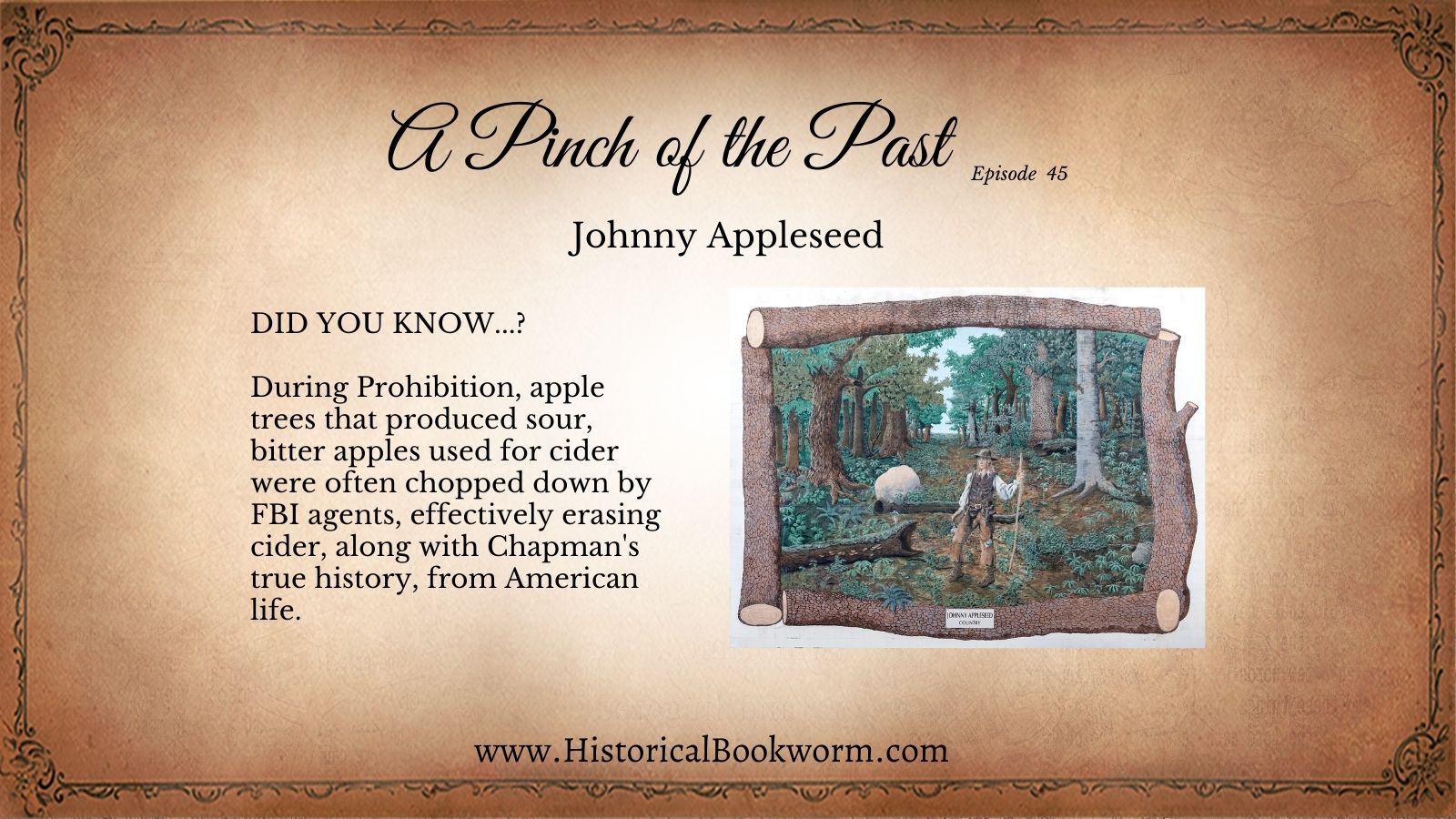The audio version of this article was first shared in Episode 45: A Bookchat about A Daughter’s Courage with Misty M. Beller & a Review of Heirlooms by Sandra Byrd
With autumn finally arriving for even the southern United States, my head is full of visions of apple orchards and apple dishes. So for today’s Pinch of the Past, we’re looking at the history of the man who made apples an American thing–the man best known as Johnny Appleseed.
Early Life
John Chapman was born in Leominster, Massachusetts, on September 26th, 1774, just two years before the American Revolution. Little is known about his childhood. His father fought in the Revolution. His mother died when he was young, and his father remarried.
When John was 18, he and his 11-year-old half-brother, Nathaniel, headed west into Pennsylvania, apparently living a nomadic lifestyle. Sometime around 1800, or a little earlier, John apprenticed under an orchardist named Mr. Crawford, where he discovered his love for apple trees.
John was in his mid twenties when he embarked on his business of starting apple nurseries. He acquired apple seeds for free from cider mills and headed west.
His Business
While legend paints Johnny Appleseed as a wandering pauper, wearing a coffee sack for a shirt and planting apple seeds in any likely clearing, John Chapman was a shrewd businessman.
In the late 1700’s and early 1800’s, private companies and speculators bought up huge tracts of land in what was called the Northwest Territories. In order to encourage settling, in 1792 the Ohio Company of Associates gave 100 acres to anyone who could establish a permanent homestead. Part of the deal involved planting a 50-acre apple orchard on each homestead.
John traveled into these territories and scouted out good places for apple nurseries. He bought the land, fenced it with fallen logs, and carefully planted his apple seeds. From time to time, he returned to these nurseries to tend the trees and sell saplings to settlers. Beginning in Pennsylvania, he eventually worked his way through the Ohio Valley as far as Indiana and Illinois, keeping just ahead of the waves of settlers. When they arrived, he had apple trees ready for them. He soon became known as the “apple seed man.”
For religious reasons, John did not practice grafting trees, believing it was harmful for the plants. Because apple seeds are so genetically unpredictable, most of his trees were basically wild apples, far too sour for eating. According to Henry David Thoreau, apples grown from seed are “sour enough to set a squirrel’s teeth on edge and make a jay scream.” Instead the fruit was milled for the juice, which was brewed into hard cider, a staple on the frontier where clean water, coffee, and tea were hard to come by.
His Religion
John was a devout follower of the Swedenborgian doctrine of Christianity. In fact, the first published writing about him was by the Church of New Jerusalem in Manchester, England, in 1817. It described him as a missionary for the church who traveled the wilderness planting apple seeds. John always carried a Bible and literature of his church; he loved discussing and arguing for his faith.
John was well-known during his life for his peculiar shabby clothing and habit of traveling barefoot–even in snow! He often preferred sleeping in the woods even when neighborly settlers would have offered a night’s shelter. He was not without means, as his nurseries could support him, but he chose to live simply. He traded apple trees for second-hand clothing, but would give it away again if he met someone he thought needed it more.
He was strictly kind to animals, even pulling his own handcart rather than owning a beast of burden to pull it for him. It’s said he didn’t even swat mosquitoes.
Rosella Rice wrote in her History of Ashland County, Ohio, that John wore a cooking pot as a hat, so his headgear served two purposes. Historians today find this doubtful as cooking pots were made of heavy tin in the early 1800’s, but Rosella Rice had met John in his later years, so who knows if it is accurate?
Legacy
John was well-liked by everyone as a news-bringer and friend, eventually picking up the nickname Johnny Appleseed. He traveled for fifty years until 1842 when he moved in with his brother Nathaniel’s family, who had settled in Ohio. Three years later, while visiting a friend in Indiana, he died of pneumonia on March 18, 1845. They say it was the only time he’d been sick in his adult life. John left a valuable estate of 1,200 acres of nurseries in Ohio and Indiana to his sister, Persis.
In spite of his planting “only” cider apples, we may have him to thank for the resilient American apple varieties today. The original trees brought from England didn’t do very well in the American soil. By his constant planting of trees from seed, it allowed nature to develop hardy varieties that thrived in the American climate.
As you enjoy an apple pie this autumn, or slice a fresh apple for a snack, think of how that Red Delicious might be descended from one of Johnny Appleseed’s trees!
References
The Real Johnny Appleseed Brought Apples—and Booze—to the American Frontier


One Reply to “Johnny Appleseed”
Comments are closed.